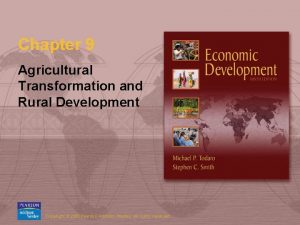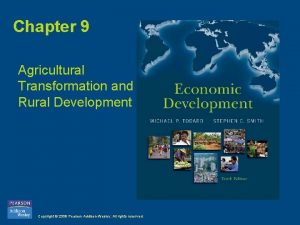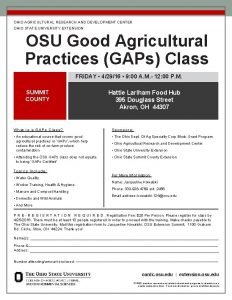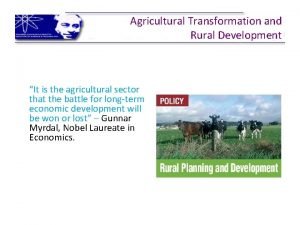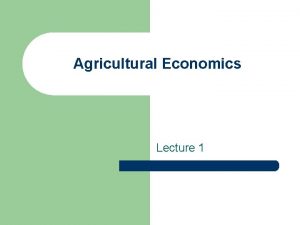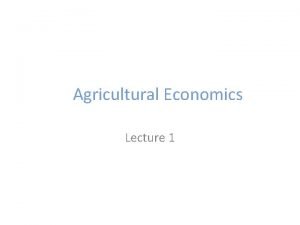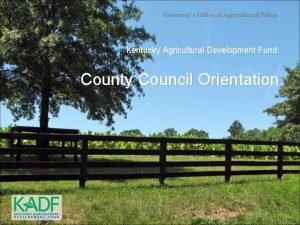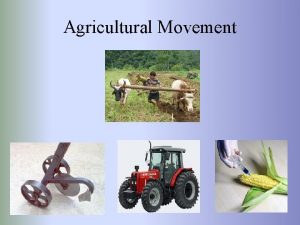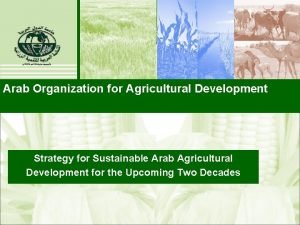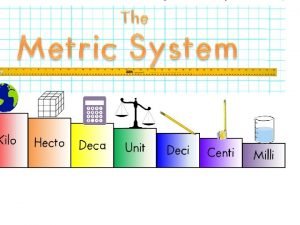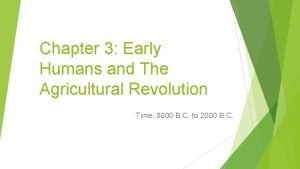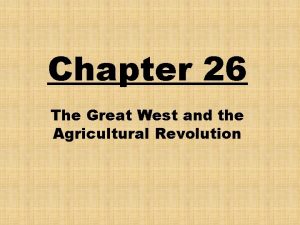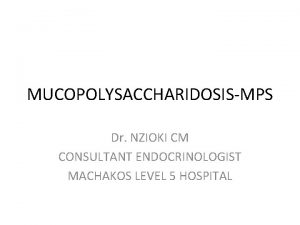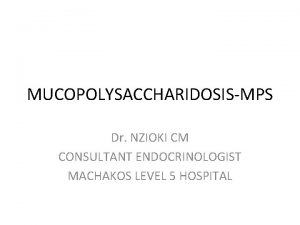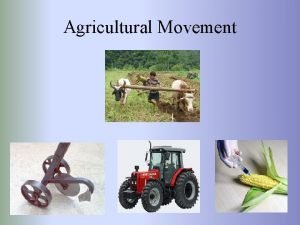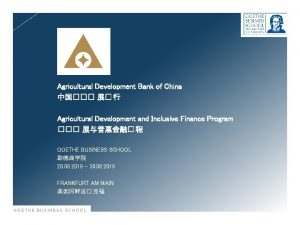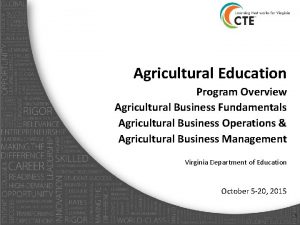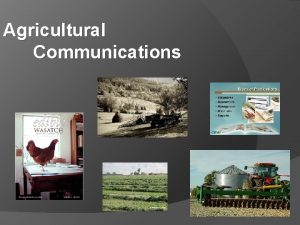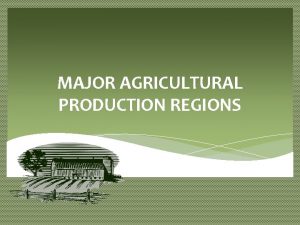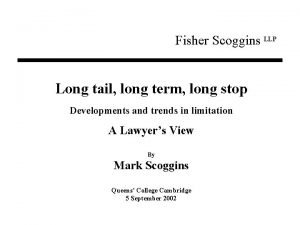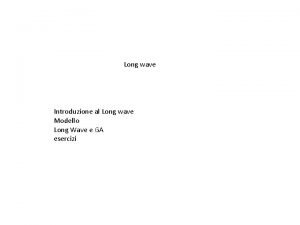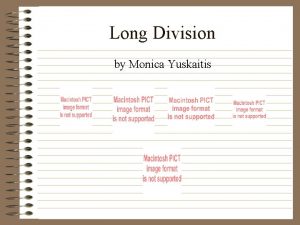Machakos A long History of Agricultural Development and






















- Slides: 22

Machakos. A long History of Agricultural Development and Research Louis N. Gachimbi National Agricultural Research Laboratories P. O. Box 14733, e-mail: inmasp@skyweb. co. ke Nairobi. Trade off Analysis: An operational and accepted tool for policy analysis workshop, Intercontinental Hotel, Nairobi June 20 -21, 2005 Kenya Agricultural Research Institute

Characteristics of Machakos District Machakos Area (km 2) 14178 Mean annual rainfall 500 -900 (Bimodal) Altitude (m. a. s. l) 340 -1710 Main soils Acrisols, Luvisols, Ferralsols Population density per km 2: Machakos Makueni 1969 -50, 1979 -72, 1999 -144 (68 -512) 1999 – 260 (80 -395) Average land size (ha) 2. 5 + co-operative/ private farms Main crops grown Maize, pigeon pea, sorghum, beans, horticultural crops and fruit trees Cattle/HH (Dairy and Dual purpose) 5 Contribution of agriculture to total household income 22% Main issues: population pressure, Land degradation due to steep slopes, persist drought, low farm incomes, low farm productivity, low Nitrogen and Phosphorous levels. Kenya Agricultural Research Institute 2

History of Agricultural Development Initiatives • Before settler occupation: - Land controlled by clans, tribes or families • With colonial rule: - Market economy -Increased population: livestock and human leading to land degradation • 1945 – African Resettlement Board (ARB) which was latter replaced by African Land Development Board (ALDEV) Kenya Agricultural Research Institute

Activities (a) Pasture improvement, soil and water conservation, livestock water development, tsetse fly eradication. (b) Modification of agro pastoralists perceptions and actions: grazing controls, ranching schemes, land tenure privatization. (c) Improvement of livestock systems through breeding, disease control and marketing (ranches) 1970 s to date: Disaster mitigation: • Ranching phase (1970 s-1980 s)- ranches heavy capital investment. • Range/livestock project (ASAL): development of water, roads and marketing infrastructure. Kenya Agricultural Research Institute

• Integrated natural resource management - Involves all stakeholders (move from top down heavy capital intensive to smaller less capital intensive). - Soil and water conservation - Agro forestry - Crop and livestock improvement • Wildlife • Large scale dairy/beef ranching • Small scale farming: Maize/beans/cowpeas/fruit trees. • Small scale irrigation schemes (Matuu, Kibwezi) Kenya Agricultural Research Institute

Research conducted for the past 10 years Research conducted in the area No. of onfarm-trials and farmers (x) No. demos and farmers (x) No. field days and farmers (x) No. study tours and farmers (x) FYM for crop production 5 (40) 8 (200) 5 (500) 1 (34) Fertilizer x FYM x tied ridges for maize and beans 6 (150) 10 (300) 4 Bucket drip irrigation for vegetable production 5 CBO demos (200) 12 farmers demos (100) 6 (500) 2 (30) Drip irrigation for fruit production 2 CBO demos (60) Farmer demos (10) 2 (90) 3 (20) Soil and Water (runoff) harvesting Zai pits, tied ridges and terracing 2 (20) 18 (120) 4 (150) 2 Dry planter for vertisols 9 difficult ASAL soils) 6 (60) Collaboration with 6 Jua kali artisans 1 (7) Others • Livestock improvements trails: Boran/zebu, disease control • Pasture improvement: water harvesting trails for pasture/fodder production, bush clearing etc. • Soil fertility: Nitrogen (N), Phosphorous (P) and Manure (FYM) trials, farm nutrient balances. Kenya Agricultural Research Institute

Farming systems in Machakos (including Makueni) • Rainfed systems in high population density areas (Central Division, Kangundo, Mwala, Kasikeu): Rainfed systems in low population density areas (Kibwezi, Yatta): • Irrigated systems (Matuu and Kibwezi) Kenya Agricultural Research Institute 7

Major characteristics of the farming systems in selected sites Matuu (*Machakos) Kasikeu (*Makueni) Kibwezi (*Makueni) Mwala (*Machakos) No. of households 24, 630 6, 852 16, 282 16, 885 Farming system characterisation rainfed + irrigated farming local cattle, maize, beans, sorghum rainfed farming Maize, Pigeon peas, beans, cowpeas rainfed + irrigated farming, pigeon peas, cowpeas, sorghum rainfed farming cross -bred cattle, maize, beans, fruits Average annual rainfall (mm) 600 700 560 600 Population size and persons per Km 2 density 22, 847 (185) 35, 719 (132) 80, 236 (85) 89, 211 (185) Total area per farm (ha) (small scale farms) 1. 5 2. 8 3. 5 3. 2 Cultivated area per farm (ha) and percent of whole farm in parenthis 1. 3(87%) 1. 6(57%) 1. 7(48. 5%) 1. 7(74%) Livestock per farm (TLU) 6. 1 5. 2 0. 8 6. 2 Distance to market (km) 8. 4 1. 2 1. 5 5. 4 Female headed households (%) 4 16 6 19 * Machakos and Makueni are the current administrative boundaries. Kenya Agricultural Research Institute

Land use patterns in selected sites: Kenya Agricultural Research Institute

Average farm total nutrient balances (kg/ha) for selected sites Kenya Agricultural Research Institute

Economics Kenya Agricultural Research Institute

Average soil nitrogen levels in selected sites Percentage of farms with observed nitrogen level (N, %) No. of farms N<0. 05 (V. Low) 0. 05<N< 0. 12 (Low) 0. 12<N 0. 25 (Moderate ) N>0. 25 (Adequate ) Mean Range Matuu 28 0 89 11 0 0. 10 0. 07 -0. 15 Kasikeu 19 0 23 68 9 0. 19 0. 08 -0. 62 Kibwezi 17 8 76 8 8 0. 12 0. 04 -0. 61 Mwala 26 23 77 0 0 0. 06 0. 02 -0. 09 Kenya Agricultural Research Institute

Average soil phosphorus (Olsen) levels in selected sites Percentage of farms with observed phosphorus (P, ppm) No. of Farms P<20 (Deficient) 20<P<80 (Adequat e) P>80 (Excessive) Mean (g kg-1) Range (g kg-1) Matuu 28 82 18 0 0. 12 0. 02 - 0. 37 Mwala 26 37 61 2 0. 26 0. 10 -1. 10 Kasikeu 19 100 0 0 0. 01 0. 00 - 0. 08 Kibwezi 17 100 0 0 0. 04 0. 02 - 0. 11 *Low levels of organic carbon due to high mineralisation rates * Potassium is adequate in the soil for common crops Kenya Agricultural Research Institute

Assessment of Poverty levels based on family earnings per consumer unit per month Percentage of farms with Observed poverty level No. of Farms Y<1239 Y>1239 Average (KShs/CU) Range Matuu 28 36 64 3, 875 -1, 591 to 36, 146 Mwala 26 69 31 1, 294 -384 to 4, 498 Kasikeu 19 37 63 3, 286 187 to 12, 397 Kibwezi 17 71 29 782 -1, 864 to 13, 281 Kenya Agricultural Research Institute

Long term agricultural developments options in low rainfall areas Goal: • Multifunctional land use • Economic development of the region • Improved livelihoods of the population • Conservation/maintenance of resource base Kenya Agricultural Research Institute

Measures: Design of development plan for livestock-wildlife-tourist industry • Feedlots for high intensity beef production • Manure processing facilities • Infrastructure: feed grains and processed manure transport, marketing, infrastructure • Improved animal health care • Localised food production with water harvesting, use of manure and rotation • Future threats: • Land subdivision • Slow adoption rates of technologies especially soil fertility options due to low returns Kenya Agricultural Research Institute

Long term agricultural developments options in areas with relatively high rainfall (Mwala and Kasikeu) • • • Dairy cows Cultivation of mono cultures of maize and grain legumes Cultivation of forage legumes for supplementary feed Efficient manure management Mixed crop-livestock systems with market orientation for milk Kenya Agricultural Research Institute 17

Measures: • Breeding and using improved cattle • Efficient recycling of crop residues, manure and organic waste and collection of waste/fallow vegetation for mulching/feed/composting Kenya Agricultural Research Institute

Future threats • Slow nutrient depletion resulting in low yields and low efficiency of external inputs • High risks of drought and crop failures; threats of food insecurity and unsure livelihood • Low recycling efficiency of manure and crop residues • Competition for labour • Livestock numbers Kenya Agricultural Research Institute 19

Agricultural development options in irrigated systems Objectives: • Maintain and expand small scale irrigated production system • High intensity, high value commodities production centred for local and export market • Improvement of livelihood Measures: • Maintenance and management of small-scale irrigation system • Reduce transaction costs: market information, physical infrastructure, marketing channels, co-operatives, micro-finance Kenya Agricultural Research Institute

Threats • Soil quality (salinization) • Water availability and competition • Marketing problems (reduce transaction costs) Measures: • Development of skills for all links in chain (production, quality control, transport, marketing) • Establishment of effective production-marketing chain in public-private partnership Kenya Agricultural Research Institute 21

Thank You Kenya Agricultural Research Institute 22
 Tall+short h
Tall+short h Once upon a time there was a little girl
Once upon a time there was a little girl Chapter 9 agricultural transformation and rural development
Chapter 9 agricultural transformation and rural development Chapter 9 agricultural transformation and rural development
Chapter 9 agricultural transformation and rural development Ohio agricultural research and development center
Ohio agricultural research and development center Agricultural transformation and rural development
Agricultural transformation and rural development What is agricultural development
What is agricultural development What is agricultural development
What is agricultural development Ag revolution kentucky
Ag revolution kentucky The stages of agriculture
The stages of agriculture Arab organization for agricultural development
Arab organization for agricultural development Tinikling props
Tinikling props Long long ago when the gods and goddesses
Long long ago when the gods and goddesses Decaliter
Decaliter Once upon a time there was a king and queen story
Once upon a time there was a king and queen story Once upon a time long ago and far away
Once upon a time long ago and far away Long long int c
Long long int c Lông vằn lông vện mắt xanh
Lông vằn lông vện mắt xanh Once upon a time a long long time ago begins the story
Once upon a time a long long time ago begins the story Bọn em hai đứa cùng tên
Bọn em hai đứa cùng tên Agricultural accounting and finance kansas
Agricultural accounting and finance kansas Early humans and the agricultural revolution
Early humans and the agricultural revolution Chapter 26 the great west and the agricultural revolution
Chapter 26 the great west and the agricultural revolution


